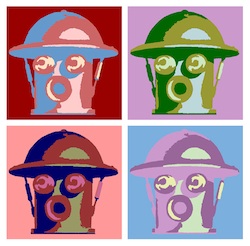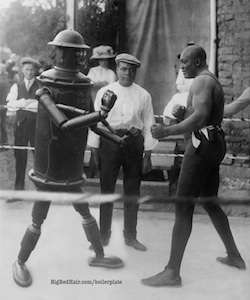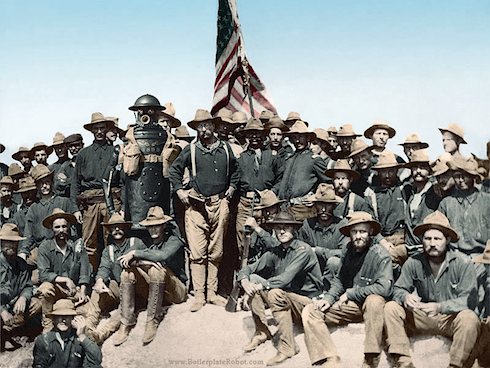According to husband-and-wife creative team Paul Guinan and Anina Bennett, comedy makes history more palatable. And sometimes, real photos (with some creative Photoshopping) reach out to geeks more than the pages of a graphic novel. That’s how they came up with Boilerplate: History’s Mechanical Marvel, which allows readers to experience key moments of the 20th century through the titular robot’s adventures. A cheeky style and fascinating mythology behind our hero elevates the work from coffee-table-book status.
But who is Boilerplate? From NYCC’s panel “Comics Studies Conference 5: Boilerplate: History of a Victorian Era Robot,” here are 5 things to know before you can start traveling through history with him.
1. He’s not a human, but he’s definitely got human qualities.
If Guinan and Bennett had been shopping around their original story today, Boilerplate probably wouldn’t exist. Guinan first conceived of the project as a historical fiction graphic novel, but because this was about 10 years ago before such things were common, they decided to just insert a robot, “to make it more science-fiction.”
Discussing Boilerplate’s looks, Guinan cited comics authority Scott McCloud’s theory on the iconography of cartoon characters’ faces: The more you abstract a face, the more universally identifiable it becomes. To that end, Boilerplate’s face consists of just three circles: His childlike eyes and his mouth that seems to be perpetually open in an o of surprise.

“I could’ve chosen a human protagonist,” Guinan said, “but as soon as you give him a specific hair or skin color, you limit your audience.”
And yet, the best comparison they have is the Young Indiana Jones book series, where an adolescent Indy travels the world and “meets a bunch of people without interfering with history, without participating in it.”
Another human to whom we can compare Boilerplate is Forrest Gump, Tom Hanks’ famous history-jumping character. However, Guinan is quick to add that the movie “is very right-wing.”
2. His life is not a graphic novel.
Although in the book’s canon Boilerplate is created by Professor Balthazar Campion, in reality he owes his creation to Teddy Roosevelt. The first inspiration that Guinan had was the image of a robot standing with the 26th President on top of San Juan Hill.
The second image that Guinan envisioned was of the 1893 World’s Fair, where Boilerplate would be unveiled. And while it would probably have been easier to draw such breathtaking scenes, the cons outweighed the pros.
“I realized that drawing it as a graphic novel would lose the realism I wanted for the piece,” Guinan said. “So I switched gears and went for the photo-history book, the kind I liked as a kid.”
3. His presence plays on comedy to make history more relatable.
Guinan and Bennett treat their material with a very tongue-in-cheek attitude; many of the books’ images have Boilerplate Photoshopped in with World War I soldiers or dead Presidents. The book is laid out like a TIME history book from the ’70s or ’80s, with episodic stories that (the creators hope) will inspire you to further research the historical events mentioned.

The team’s follow-up is Frank Reade: Adventures in the Age of Invention, based on the real magazine. Not only was this the first sci-fi periodical, but it was also the first instance of robots (or “steam-men”) in fiction. Too bad it was imperialistic and awful.
“Boilerplate is kind of like The Daily Show, and Frank Reade is like The Colbert Report!” Bennett said. “We’re taking on this neo-con persona, but expressing the same things we did with Boilerplate.”
4. He doesn’t create alternate history.
Boilerplate affects history in sly ways, without causing nuclear devastation in the present or other life-altering changes. That said, there’s a method to his various jaunts around the United States.
“There’s no coincidence,” Guinan said. “He doesn’t just ‘happen’ to be there when something goes down.”
Boilerplate has equal interactions with key events and famous people. The writers actually already know his “ending”: Inspired by the story of Amelia Earhart’s disappearance, he goes missing during World War I.
Bennett explained that when writing counterfactual history, you just have to pick which interpretation of historical figures you’re going to go with: “I can’t tell you everything about Teddy Roosevelt in this book because there’s already a hundred books out there that don’t tell you everything.”

5. He represents the best and most hopeful elements of steampunk.
Boilerplate—the book and the robot—has been described as “a gateway drug for steampunk” because of his appearance and the counterfactual events depicted.
“What attracts people [to steampunk] is the ‘what-if,'” panelist Ay-leen the Peacemaker explained. “Not just the dirigible and ray guns, but it’s taking the inventions and patents that actually existed—if only they were successful, if only they worked the first time, what would’ve happened?”
Today’s technology, while incredibly advanced, is increasingly fragile. “I love my iPhone,” Bennett said, “but you can’t even change the battery.”
As Ay-leen explained, steampunk technology is very tactile: By turning gears and pulling levers, you forge a more intimate connection with your machine. “I think people find that physical embodiment of technology more intimate,” she said.
Steampunk literature has to skirt the issue of not idealizing the Victorian era, which was a racist, sexist period. However, the way that Ay-leen described steampunks’ approach is germane to Boilerplate‘s style of storytelling: “[They say,] ‘We’re not reenactors, we’re reimaginers.’ There are many things we’re angry about, like Occupy Wall Street and the state of alienation and isolation from our own technology. [This] lack of community we feel is directly related to how we interact with each other. It’s about questioning modernity, and how did our society get this way. We really screwed up in the past, but if we can remake the past, we can make it better.”
Natalie Zutter is a playwright, foodie, and the co-creator of Leftovers, a webcomic about food trucks in the zombie apocalypse. She’s currently the Associate Editor at Crushable, where she discusses movies, celebrity culture, and internet memes. You can find her on Twitter @nataliezutter.










